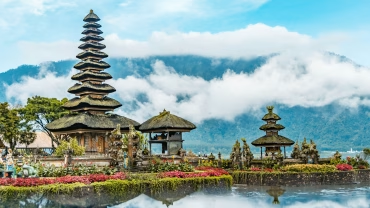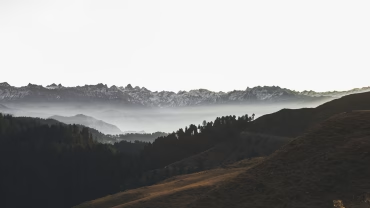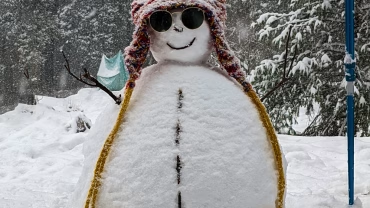Introduction to Winter Spiti Expedition
The Winter Spiti Expedition is a mesmerizing journey into one of the most remote regions of India, the Spiti Valley. Nestled in the heart of the Himalayas, Spiti Valley boasts a unique geographical significance, often referred to as the “Middle Land” due to its location between Tibet and India. During the winter months, from December to March, this barren landscape becomes even more enchanting, as thick layers of snow envelop the rugged mountains and quaint villages. The stark contrast of white snow against the azure sky creates an unparalleled visual spectacle that draws adventurers from around the globe.
Traveling to Spiti in winter is a distinctly different experience compared to the bustling summer months. The silence of the snow-laden landscapes and the absence of tourists add to the serene aura of this region, making it a perfect destination for those seeking solace away from the humdrum of city life. The iconic monasteries, such as the Ki Monastery and Tabo Monastery, exude a mystical charm, while the remote villages offer insights into the rich cultural heritage of the local communities. Winter travel also provides a unique opportunity to witness how the inhabitants adapt to the harsh climatic conditions, creating a truly immersive experience.
The Winter Spiti Expedition is not just about exploring the stunning landscapes; it is about embracing the challenges and unpredictability that winter travel presents. From navigating through snow-clad treks to experiencing the warmth of local hospitality, every moment becomes a cherished memory. As adventurers dive deeper into this winter wonderland, they uncover the numerous hidden gems that lie within, ranging from frozen rivers to breathtaking panoramic views. The allure of this expedition lies in its promise of adventure, exploration, and unforgettable experiences.
Planning Your Winter Spiti Expedition
Embarking on a winter expedition to Spiti Valley demands thorough planning to ensure a safe and enjoyable experience. The ideal time to visit Spiti during winter is from late December to early March. This period offers breathtaking snow-covered landscapes, but it is crucial to acknowledge the extreme weather conditions that accompany this season. Those planning a trip must be equipped with suitable travel arrangements, as access to certain areas may be limited due to heavy snowfall.
Travelers should consider flying into Kullu or Shimla and then embarking on road trips via rented vehicles or local taxis. It is advisable to check road conditions and weather forecasts regularly. Additionally, arranging for a local guide could enhance the experience by providing invaluable insights into the region’s culture and ensuring safety through challenging terrains.
Preparation for extreme weather is paramount. Proper gear will significantly impact comfort and safety during the journey. Essential items include thermal clothing, insulated jackets, waterproof boots, and sturdy gloves. A reliable snow shovel, weather-resistant bags, and portable heaters can also contribute to a more pleasant outing. Travelers should ensure their equipment can withstand freezing temperatures and inclement weather, as conditions can change rapidly in the mountains.
Another critical aspect is obtaining the necessary permits. While visiting Spiti is generally simple, certain areas may require special permissions, particularly near the Indo-Tibetan border. It is advisable to research permit requirements well before departure and to allow ample time for processing. Engaging with local tourism offices or established travel agencies can facilitate this aspect of the planning process.
Lastly, travelers should be mindful of potential health issues related to altitude sickness, and acclimatization is essential. Staying hydrated, eating nutritious meals, and granting the body sufficient time to adjust are recommended approaches when navigating this remarkable yet remote area.
Getting There: Travel Routes and Transportation
Reaching Spiti Valley during the winter months poses a unique set of challenges and adventures that require careful planning. The primary route to reach the valley is via the Manali-Kaza road, which remains the most popular travel route. However, during the winters, this road can be subject to heavy snowfall, leading to potential road closures. Therefore, travelers must stay updated with the weather forecasts and seek current travel advisories before embarking on their journey.
Another viable route involves starting from Shimla to Kaza, which has a slightly lower chance of snowblockages. Nevertheless, the condition of these roads can fluctuate drastically, so checking in with local resources for real-time conditions is advisable. For those seeking a more immersive experience, traveling by a private vehicle allows greater flexibility, but caution must be exercised as winter driving in high-altitude regions can be demanding due to icy roads and visibility issues.
Public transportation also serves as an option for those not wishing to travel by personal vehicle. Buses operated by the Himachal Pradesh Road Transport Corporation (HRTC) connect major towns to Kaza, yet these services may have limited availability during the winter months. Therefore, it’s wise to book tickets beforehand and remain adaptable to potential delays or cancellations.
Regardless of the chosen mode of transportation, adequate preparation is essential. Carrying essential supplies such as extra warm clothing, food, and blankets can prove beneficial, as delays are quite common due to weather conditions. Additionally, planning stops at local eateries or guesthouses en route allows for rest and a chance to savor local cuisine, enriching the overall travel experience. By minimizing risks and maximizing enjoyment, winter travels to Spiti Valley can transform into a captivating adventure.
Accommodations: Where to Stay in Winter Spiti
Winter Spiti offers a unique blend of adventure and cultural richness, particularly when it comes to accommodation options. Travelers can choose from various lodges, homestays, and guesthouses, each providing a different experience suited to the rugged landscape and frigid temperatures. Most accommodations in Spiti are designed to withstand the harsh winter conditions while offering warmth and comfort to guests.
Lodges in the region often feature well-heated rooms, equipped with basic amenities such as hot water and electricity, which are essential during the cold months. For example, the highly recommended “Spiti Village Homestay” not only provides cozy lodging but also allows guests to enjoy authentic local cuisine. This enhances the overall travel experience, offering insight into the daily life of Spiti residents.
Homestays are particularly popular in winter, as they provide a more intimate experience with local families. Staying in a homestay allows visitors to engage with their hosts, learn about traditional living, and even participate in local customs. A great choice is “The Dhakpo Homestay,” where visitors can experience the warmth of local hospitality while enjoying the stunning views of snow-capped mountains outside their windows.
Guesthouses also serve as a reliable option for travelers seeking a more social atmosphere. The “Lingti Guesthouse” is noted for its welcoming ambiance and offers shared spaces, allowing for interaction among guests. These accommodations tend to be less expensive and cater to budget travelers without compromising on comfort. It is vital, however, to book in advance, as winter keeps many establishments open at limited capacity.
In summary, the winter accommodations in Spiti Valley not only provide shelter from the cold but also allow travelers to immerse themselves in the local culture. Each lodging option contributes to an unforgettable adventure, making it essential for visitors to explore these varying choices during their winter expedition.
Must-Visit Attractions and Activities in Winter Spiti
Winter Spiti offers a unique landscape dotted with captivating attractions and experiences that are bound to leave a lasting impression on visitors. One of the prime destinations within the valley is the Key Monastery, perched on a hill with breathtaking views of the surrounding snow-covered mountains. This ancient monastery is not only a spiritual center but also a significant cultural hub, where visitors can witness the vibrant traditions of the Buddhist community.
A short distance away is the village of Kaza, the administrative capital of Spiti Valley. Kaza serves as the perfect base for exploring the region, providing access to several unique activities. Here, one can engage in snow trekking, a thrilling experience that allows adventurers to traverse the pristine snowy landscapes. The trekking routes, framed by dramatic cliffs and serene valleys, offer unparalleled opportunities for photography, showcasing the untouched beauty of winter in Spiti.
Another must-visit village is Langza, known for its fossil-rich landscape and traditional homes. In winter, the village transforms into a picturesque scene against a white canvas, where visitors can engage with local traditions and learn about the unique culture of the Spiti people. Engaging with the locals enhances the experience, offering insights into their daily lives, customs, and wintry celebrations.
For those interested in photography, winter in Spiti presents endless opportunities. From the glittering icicles hanging off rocks to the sweeping vistas of snow-clad mountains, every corner of this valley is picture-perfect. Capture the magic of the Hudumal Winter Festival, a vibrant celebration characterized by traditional music, dance, and local delicacies, offering a glimpse into the rich cultural heritage of this remote region.
Each of these experiences contributes to the allure of the Spiti Valley during winter, making it an adventure of a lifetime for every visitor seeking both beauty and cultural depth.
Winter Spiti: Challenges and How to Overcome Them
The Winter Spiti Expedition is an endeavor that attracts a myriad of adventurers, eager to explore the breathtaking landscapes of this remote region. However, various challenges accompany this journey, making it essential to prepare adequately. One of the foremost difficulties is the extreme weather conditions. Temperatures can drop significantly, sometimes reaching as low as -20 degrees Celsius. It is crucial for trekkers to invest in high-quality, insulated clothing and gear to ensure warmth and safety.
Altitude sickness is another concern, as the Spiti Valley is located at an elevation exceeding 14,000 feet. Symptoms may include headaches, nausea, and dizziness. To mitigate these effects, adventurers should acclimatize gradually—spending a day or two at lower altitudes before undertaking more strenuous hikes. Staying hydrated and consuming a balanced diet rich in carbohydrates can also be of immense help in combating altitude-related issues.
Accessibility is yet another challenge associated with Winter Spiti. The roads are often covered in snow, making travel difficult. It is advisable to plan the journey during peak winter months when local guides are available to navigate the terrain. Relying on local knowledge not only ensures safety but also enriches the experience, as these guides can share invaluable insights about the region’s culture and history.
Many travelers have encountered obstacles during their expeditions, yet the stories of resilience and determination are what make Winter Spiti memorable. One hiker recounted how a treacherous snowstorm almost derailed their journey; however, with the support of their guide and fellow trekkers, they forged ahead, ultimately reaching their destination. Such experiences underscore the importance of preparation, safety measures, and reliance on local expertise to not just endure challenges but also to thrive in this spectacular environment.
Cultural Experiences in Spiti Valley
Spiti Valley, often referred to as the “Middle Land,” is not only a haven for adventure seekers but also a rich tapestry of culture and tradition. The valley is deeply influenced by Buddhism, which serves as the backbone of the local community’s spiritual life. Travelers visiting Spiti are often welcomed to participate in various cultural experiences that illuminate the region’s traditions and practices.
One notable aspect of Spiti’s culture is the vibrant festivals celebrated throughout the year. Events such as the Losar Festival, marking the Tibetan New Year, offer visitors a unique glimpse into local customs. The festivities often include colorful processions, traditional dances, and the chanting of age-old mantras, allowing travelers to witness the community’s vibrant spirit. Additionally, significant rituals, such as the local butter lamp ceremonies in monasteries, provide an opportunity to engage respectfully with the spiritual practices that bind the locals together.
Community engagement in Spiti goes beyond mere observation; it is an invitation to interact with the people and understand their way of life. Local villages often open their doors to travelers, allowing them to partake in daily activities such as farming or pottery making. This hands-on experience facilitates a deeper connection, fostering mutual respect between visitors and locals. It is paramount for travelers to show consideration for cultural sensitivities by asking for permission before participating in any religious or community activities.
In addition to festivals and community interactions, travelers are encouraged to explore the local cuisine, which holds significant cultural value. Sharing a meal with a Spiti family can be a transformative experience, reflecting the warmth and hospitality of the region. By engaging with the local culture in this manner, visitors can create meaningful memories while respecting the values and traditions that define Spiti Valley.
Food and Cuisine of the Spiti Valley
The Spiti Valley, nestled in the northern Himalayas, offers a unique culinary landscape that reflects its rich traditions and local resources. During winter, when the valley is cloaked in snow, the food becomes both a source of warmth and nourishment for the local population. The traditional Spitian diet primarily comprises staple ingredients such as barley, wheat, and potatoes, which are adapted to the harsh climate and high altitudes. One of the most revered dishes is ‘Thukpa,’ a hearty noodle soup that provides essential warmth and sustenance during the frigid winters. Made with fresh vegetables, meat, and a flavorful broth, Thukpa encapsulates the essence of local cuisine.
Another must-try dish is ‘Chura,’ which consists of crumbled barley bread often served with butter tea, or ‘Puru,’ a fried snack that is perfect for those looking for something crispy. Local ingredients, prominently featured in these meals, include organic barley from nearby farms as well as fresh produce like turnips and carrots, which thrive in the region’s short growing season. The intentional use of these ingredients not only reflects local agricultural practices but also demonstrates respect for the environment and sustainability.
Food plays a central role in Spitian culture, often serving as a medium for community bonding. Visiting a local home for a meal provides a rare glimpse into traditional customs, where hospitality knows no bounds. Guests are often greeted with ‘Chai’ (tea) and ‘Tsampa,’ a roasted barley flour, fostering an environment of warmth and camaraderie. Community feasts, typically held during local festivals or gatherings, further exemplify the significance of sharing meals in Spiti’s cultural fabric. For an authentic experience, visiting local eateries in towns like Kaza or participating in a home stay can immerse visitors in the culinary delights of the valley.
Final Thoughts: Why You Should Experience Winter Spiti
Embarking on the Winter Spiti Expedition is an opportunity to delve into a unique blend of adventure and cultural immersion, set against the breathtaking backdrop of one of India’s most stunning yet remote regions. The mesmerizing landscapes of snow-covered mountains, frozen rivers, and quaint villages invite travelers to experience nature in its most pristine form. This journey unfolds the beauty of an untouched winter wonderland, where the tranquility and serenity of the environment create a perfect escape from the hustle and bustle of daily life.
Adventure travel, particularly in the winter months, offers transformative experiences that are hard to replicate elsewhere. Participants often find personal growth through challenges faced during the expedition, be it navigating through challenging terrain or adapting to the extreme weather conditions. These trials foster resilience and independence while simultaneously connecting travelers with the captivating spirit of Spiti’s culture. Meeting the local communities and understanding their lifestyles amidst the frosty environment encourages deeper appreciation and respect for diverse ways of life.
Furthermore, Winter Spiti is not just about the thrill; it is about creating connections — with fellow adventurers, local residents, and the surrounding nature. Each moment spent in this picturesque landscape provides opportunities for reflection and mindfulness, encouraging one to appreciate the richness of life. Those who step outside their comfort zones often return home with lasting memories, heartwarming stories, and a renewed passion for exploration. This expedition offers an invaluable chance to broaden your horizons and cultivate a spirit of adventure.
In conclusion, the Winter Spiti Expedition is an adventure of a lifetime, rich with diverse experiences that linger long after the journey is over. Whether it’s for the breathtaking views, the cultural encounters, or personal growth, this expedition promises not just memories, but a deeper understanding of oneself and the world.





Comment (0)